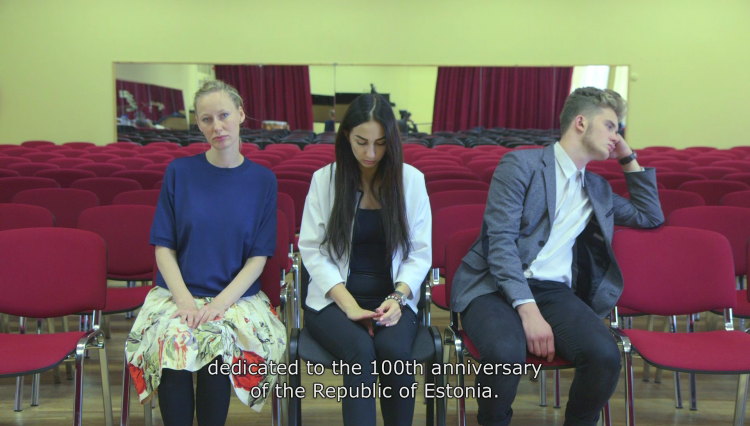Picture: Frame of Festive Spaces.
Video and text by Kristina Norman, artist
The video performance Festive Spaces (2016) was originally commissioned by Annely Porri for the exhibition Silence. Darkness. – If we know what was, do we know what will come? The show was on display at the Tallinn Art Hall in autumn 2016 (1). In the video, I explore how art can be subjected and reassigned by different political regimes.
Single-channel video with sound, 30′. Courtesy of the artist.
FESTIVE SPACES with english sub on Vimeo.
Festive Spaces is a documentation of a dramatized lecture-performance which I structured around the notion of a festive space and presented as a series of imagination exercises. There are three ceremonial halls that I connect in the piece and which are representative of different ideological regimes of Estonian history. All the three rooms are the most festive spaces in the institutional buildings where they are located, but only two of them are decorated with art. The first one is the main hall of the Estonian History Museum, situated in the historical Maarjamäe castle. As its decoration, it has the largest mural ever painted in Estonia – The Friendship of Nations by Evald Okas, one of the most renowned Estonian painters of the Soviet time (2). Okas painted the mural at the decline of the Soviet era, in 1987. The second room scrutinized in the video is the White Hall in Toompea castle which is the home to Riigikogu, the Parliament of Estonia. There you have two lunette paintings from 1937 – The Triumph of Estonia and Industry and Agriculture by August Jansen, an artist on familiar terms with the authoritarian government of the pre-WWII sovereign Estonia (3). The last of the three rooms I am discussing in the piece is the ceremonial hall of a Russian-language school in Lasnamäe district of Tallinn (4). As already mentioned, regardless that the hall is supposed to be the most festive space of the institution, it appears to have no decoration at all. In my lecture, I try to bring into view the political significance of these aesthetic circumstances of the three halls.
As the material for this media-critical work I use two pieces of news aired on the national TV, one involves the mural by Okas and the other one the lunette paintings by Jansen. The „picture scandal“ (pildiskandaal) broke out in autumn 2014 and concerned a class photograph taken in the hall of the History Museum, as part of an inauguration ritual of first-graders of the Russian-language school of Lasnamäe. According to the National Broadcasting, taking pictures against the background of The Friendship of Nations has an anti-Estonian undertone, as its iconography depicts Soviet symbols and subjects. The second piece of TV-news is from 2013 and is about the decision to restore and put on public display in the Parliament building the two Jansen’s paintings representative of the authoritarian regime of the 1930s.
Besides that my artwork is an endeavour in exploring how ideological art takes up new meanings and functions in different historical contexts, it also tries to highlight the inconsistencies in the official historical narrative today, when it comes to the condemnation of the undemocratic regimes that ruled the Estonian nation in the last century. In addition, Festive Spaces is an attempt to show what lies at the other end of the official identity policy, which aims to deny agency to the largest ethnic minority to choose places where to carry out collective rituals that help them to connect with a centuries-long history of the presence of Russian culture in Estonia (5).
References
(1) Festive Spaces is based on a site-specific live performance titled Star-Bright Hour (Tähetund) which I gave in the Estonian History Museum in August 2015. The piece was produced by SAAL Biennaal performance art festival. Anneli Porri’s curatorial text for Silence. Darkness… can be found here: http://www.kunstihoone.ee/en/events/silence-darkness/
(2) Evald Okas, 1915 – 2011.
(3) August Jansen, 1881 – 1957.(4) Lasnamäe is a Soviet-era residential area of Tallinn with the largest Russian-speaking community of Estonia.
(4) Lasnamäe is a Soviet-era residential area of Tallinn with the largest Russian-speaking community of Estonia.
(5) Long before the castle of Maarjamäe became the History Museum and before Evald Okas painted Soviet symbols on its walls, it was a summer residence of Russian count Orlov-Davydov, 1837-1905.
